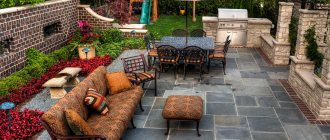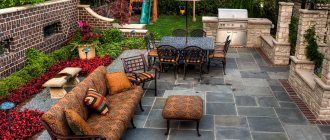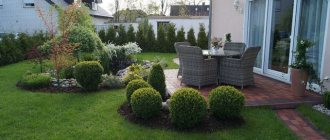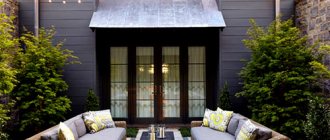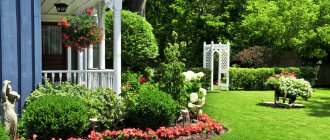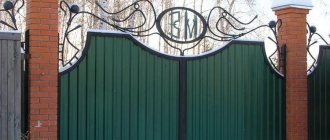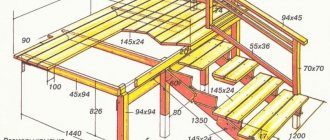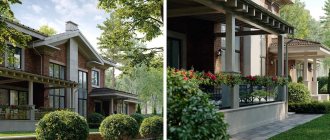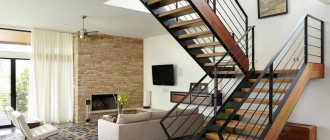Home » Yard and garden
Yard and GardenHouseLandscape Design
Novozhenina Anna
170596 Views 3 comments
A well-kept yard allows you to frame your home favorably, provides self-presentation and the basis for further impressions. Well thought out and organized yard design and landscaping should complement the natural surroundings and continue the interior design intent. Everything will be discussed in more detail later in the article.
Backyard Makeup Ideas
After reviewing the basic rules of landscape design, move on to landscaping the space. Check out the ideas below for landscaping your backyard.
Replace obsolete materials
For this purpose, solid concrete with brick strips is now often used. Make a patio area with concrete, add white sand and add a fountain for dramatic effect.
Enlarge your patio area
A common backyard mistake is making the patio too small. When you're working on your backyard makeover, consider extending the patio to accommodate larger furniture and provide walking around the space.
Patio is a useful yard decoration
Re-paving
Plain gray concrete can be quite boring. Transform your backyard pavers to transform the feel of your entire area. When redoing paving slabs, you have two options: remove the existing sidewalk or transform what you have. Create stains and etchings on the concrete path to make it look like natural stone. If you want to remodel your existing paving, you'll save money on materials and labor.
Low cost garden paths
Don't let small or awkward spaces limit you
Tight spaces can be a challenge and often end up going unused. However, you can transform a narrow space into a backyard fully equipped for outdoor activities. Creative layout and space-saving techniques can be used to fit more features into a small or awkward backyard.
DIY your backyard
You can remodel your backyard yourself, without professionals and their resources, if the matter is limited to feasible work. However, this does not include demolition and installation of new small architectural forms, as this work will take the average homeowner weeks to complete, while a team of professionals can do it in a few days.
Lots of ideas for creating beauty
Projects that involve installing running water, gas, or electrical lines may be additionally complicated. If you want a fountain, a built-in grill, or lots of lighting, it's best to hire a licensed professional. However, when choosing a DIY option that will save you some money, consider planting your own plants. If Make sure you know the requirements for each plant to choose the best location. Consider also installing a patio area yourself.
Site development
When planning a house and yard, do not forget about the garden. Fruit trees and shrubs, vegetable beds are distributed in such a way that there is enough space and sunlight for all crops.
Sidewalks and garden paths
When landscaping a site, the first step is to build paths and divide the site into zones. And then they install fences, install a playground and arrange a recreation area.
Often, non-standardly laid paths become a decoration of the entire site. There are a lot of trail options. For their construction, tiles, paving stones, and cut stone are used. If you do the paving of the path yourself, then the only expense will be the purchase of materials.
Paths decorated on one or both sides with low green spaces look elegant.
You should not immediately purchase paving slabs for garden paths. Look for original options. Look on the Internet. For example, if there is a cut tree on the site, cut the trunk into circles and lay out a path. And fill the gaps with sand or bark.
The yard path depends on the material used. Classification of house paths:
- stone options: paving stones, pebbles, crushed stone, paving slabs;
- wood coverings: boards, log cuts;
- paths made of brick or concrete;
- paths made from scrap materials.
To visually divide the local area, low fences made of annuals, perennials and dense bushes are used. To surround a recreation area or sports ground, use a low picket fence.
Pergolas for paths and arches will become beautiful and original fencing.
For such structures, climbing roses, clematis, climbing morning glory, and ivy are used.
Patio Design Ideas
Patios are all about outdoor living. You'll likely spend many hours with friends and family on your patio. Instead of purchasing a large home, many people are looking to expand their outdoor living space. The result is a larger, more luxurious and more secure patio area.
Outdoor patios have become hubs of activity, focused on entertainment and relaxation. A well-designed patio will not only add additional living space to your home, but will also increase its resale value.
Organization of a recreation area
Since your patio will provide the foundation for your outdoor living space, it should be durable, well-constructed. There are a variety of patio and paving materials to choose from. Determine what size, shape and style of patio best suits your needs. Use the information here to start collecting ideas for your new patio.
It's time to stop thinking of your patio as just a place to spend time outdoors. It can serve as a hub for a variety of functions including dining, cooking, socializing and relaxation. The style of your patio will change depending on what features you want to accommodate.
EXAMPLES OF OUR PROJECTS 2020-2021
Comprehensive improvement in Zarechye
Description:
Complex landscaping of the site
Area:
800 m2
Duration:
3 working days
Comprehensive improvement in Dedovsk, Moscow region - stage 2
Description:
Complex landscaping of the site
Area:
600 m2
Duration:
3 working days
Drainage installation in Bogorodskoye
Description:
Drainage installation on a site in Bogorodskoye
Area:
33 m.p.
Duration:
2 working days
Storm drainage system in Ashukino
Description:
Construction of drainage and storm sewerage on a site in Ashukino
Area:
102 m.p.
Duration:
4 working days
Comprehensive improvement of Beloozersky, Moscow region
Description:
Complex landscaping of the site
Area:
800 m2
Duration:
6 working days
Concrete patios
The durability and versatility of concrete makes it an excellent choice for paving your patio. A concrete patio has many advantages compared to corrugated sheets and other surfaces.
Concrete patio in the courtyard interior
Benefits of concrete patios:
- Highly durable.
- Low operating costs.
- Adaptable to any style.
- Can be poured into any shape.
Decor options:
- Colored concrete. There are several ways to paint concrete, including contrasting, integrating, solid and liquid painting methods (used in combination with embossing), and full staining.
- Embossed Concrete – The surface of your concrete patio can be stamped to create a texture that mimics stone, brick or other materials.
Embossed colored concrete to look like stone
If you already have a patio that is cracked or dirty, you can clean it with concrete. Concrete sanding will make your patio look like new. A reclaimed concrete patio can be painted and stamped.
Another strong trend is to integrate plants into areas where expansion joints would otherwise be located. They help create a more breathable surface and break up the vast structure with greenery. It is not uncommon to use artificial turf in these areas, especially in areas where moisture needs to be maintained.
Grass between seams to maintain moisture
Are concrete patios susceptible to cracking?
Concrete is good for warm climate landscapes that do not experience the extreme freeze-thaw cycles of northern regions that cause uncontrolled cracking. Other factors can also lead to cracking.
This will be of interest to you: Do-it-yourself landscape design for the garden (185+ Photos). Styles You Should Know About
Flower beds
Flower beds are an important element when arranging a yard. When the area is tiny, you can still find a place for flowers.
There are several types of flower beds:
- regular flower beds where a variety of plants grow, the flowering of which is observed at different specific times;
- irregular flower beds are planted with plants that bloom throughout the warm months of the year;
- raised flower beds are built from a variety of frames made of wood, metal, stone, brick;
- vertical flower beds decorate walls, low buildings and fences;
- carpet flower beds;
- monoflowers, consisting of only one type of plant;
- original borders;
- discount: different plants are planted on one side;
- arabesque: low-growing crops are planted in the form of various geometric figures;
- alpine slide: compositions of flowers, ornamental plants and stones;
- front gardens: plants are placed in front of the building and near the road;
- mixoborders: a composition of mixed plants, planted along houses, paths and fences.
Ideas for gazebos
Gazebos and other shade structures are another way to enjoy nature even if the conditions outside are not the best. During the hot summer, you can relax and have fun outdoors without getting sunstroke. Shade structures also extend the season into fall and winter. If your structure is built with a solid roof or even insulated walls, you can enjoy calm winter mornings while sipping tea without the worry of rain or snow.
Cozy gazebo for summer relaxation
Types of shadow buildings
Gazebos are a self-contained structure, organically placed in the landscape. They can stand on a path and define a space for a walk, or they can define a patio area or outdoor entertaining space. A pergola usually has open sides and a slatted or solid roof.
Pergolas in landscape design
Patio structures are similar to pergolas, except they are attached to the house. This can be an advantage because the patio area can use the house for support and therefore can cost less than a freestanding structure.
Octagonal-shaped gazebos with a durable roof are most often used in traditional gardening areas. They can be an attractive addition if the style of the surrounding landscape works with the structure.
Traditional garden and park area
A canvas canopy is a modern way to get relief from the sun. The fabric is stretched through specially designed posts to accent and cover a seating area or patio. A canvas canopy looks great with the straight lines and simple geometries used in modern homes, and does double duty as a decorative and artistic part of the landscape.
Canopy for gazebo
A screened deck is built right next to the home, usually at the back door for easy access. Instead of glass windows, it has large screens to keep out insects. A screened terrace is great for dining as you get quality time outdoors without any uninvited guests.
A sun room is also being built right next to the house. Because it can be fully insulated and built with two-pane windows, it is a four-season structure that acts as an addition to your home. The sunroom is completely weatherproof, so you can watch birds and wildlife in comfort, even in winter. What really sets a sunroom apart from the rest of your home is that it has lots of windows that enhance outside views.
Pristine beauty
Those who make fewer changes will spend less on design.
The deliberate brutality and naturalness of log and plank walls has a special charm, and bare beams and ceilings often look better than a carefully sewn and finished ceiling. For whom: admirers of natural wood and those who, on a limited budget, are not ready to compromise on style.
Terrace decoration
No matter what size backyard you have, you can make the most of the available space and live the dream. Here are some easy DIY landscaping ideas to create a great outdoor space that you can enjoy day and night.
Customize your space with decking
There's nothing like a new deck to transform your backyard into an outdoor living room or a great party spot. It's an easy, affordable way to expand your living space that will last for many years, and with a little know-how, you can build it yourself.
Terrace – a room with decking
There are several options for decking materials. In addition to traditional wood flooring, there is an eco-friendly alternative. Composite decking can be made from recycled plastic, which is durable, easy to install and maintain, and resistant to rot and pests.
Build with beams
Beams made from environmentally friendly material
You can shape your backyard to any size and give it a natural, earthy look with treated pine beams. Treated pine beams are resistant to decay, fungus and pests, making them one of the most versatile, easy-to-use and hard-wearing landscaping materials on the market. They can be used to create a retaining wall, stepped garden, flower bed or as a border along your beds.
Space with retaining walls
Retaining walls are a great way to create interesting steps for your backyard design. You can use them to create a raised garden to surround your entertaining space or create a quiet corner to unwind. Retaining walls are also a good way to level out areas of sloping block and add extra space for the kids to play or for you to entertain. Depending on the look you want, retaining walls can be made from logs or treated pine sleepers. Use specially formulated wall holding materials that are interlocking, durable and come in a range of colors.
Own paving
You can add real definition to your backyard and create a great look with pavers. Plus, it will be an easy project that you can do yourself. Pavers make a solid base for your outdoor entertaining area, or you can create a path through your garden. There are a variety of colors and installation designs on the market to suit any backyard, from concrete textured pavers, panel pavers, and sand pavers.
Simple and convenient covering for the yard
Add color and texture with pebbles
Pebbles are an easy way to bring different colors and textures to your backyard. You can use it to fill empty spaces in garden beds or as a ground cover to complement a paved or decked area.
For a purely decorative look, you can use pebbles to create a border or landscape path. There are many colors and styles to choose from in white, blue, orange, red, green, lime, silver or gold. Using the same colored pebbles, you can create solid colored areas or mix colors to create a brighter look.
Bright flowerbed using pebbles
What yards are not accepted to participate in the program?
The decision to include a yard in the project is made at the budget level. In accordance with the terms of the project, the following list of restrictions has been established:
- if there are emergency buildings in close proximity to the yard that are subject to demolition during this period;
- when carrying out repairs or replacement of utilities running through the yard planned for a given year;
- if new buildings have been erected in the areas adjacent to the yard, in which the warranty period has expired upon commissioning;
- in the case when the types of work that the residents planned to carry out were already carried out at the expense of the local budget
It is recommended that you check with your municipality in advance about these restrictions.
Front yard landscaping
When it comes to decorating your front yard, you'll want to think about what features of your home will be highlighted, as well as how you can transform it into an outdoor space that gets lots of use. If you want to spend your holiday time there, privacy will be key. Privacy can be created with a wall or hedge.
Get a new perspective
Before choosing a project, look at your landscape with fresh eyes and a broader perspective. We are so accustomed to our landscape that it can be difficult to determine what others might see. There are two simple tricks to see the landscape from a new perspective. With both of these methods, the goal is to forget what you think about your landscape and instead look at what actually exists.
The first is an old artist's trick. Get far enough away from your landscape that you can see everything at once. Then squint your eyes until the picture blurs and try to clear your memory.
“Paint” your picture to create a landscape
There may be areas that, when viewed blurredly, appear dark and overgrown. Some areas may look messy because there are too many small plantings, statues or pots. Or, you may have an area that is bright and clean, but a little too empty. All these ideas can give you a general idea of which projects to tackle first.
The second technique you can use to see your landscape with new eyes is to take black and white photographs of your landscaping. By adding color, you can make a familiar space feel new, so you see it with objective eyes. Nowadays, most digital cameras have a black and white setting, so this is easy to do even if you are not a techno genius.
Define boundaries and add mulch
Clean edges deceive the eye, creating a neat and well-kept landscape. If the lawn has encroached into the garden beds and created an uneven line, defining a boundary can improve the appearance of the entire landscape.
Start by laying out a garden hose to define the new boundary. Don't make the beginner mistake of creating a wavy "drunk snake" line. Instead, make wide curves that are scaled to the size of your home. Then use a hoe to cut the grass until you have a clean, attractive line.
Define a beautiful mulch line
Once you've established a neat border, add a layer of wood chip mulch for a sophisticated look. The bright color is attractive, smoothes out uneven soil surfaces and generally gives landscaping a professional finish.
Trim huge bushes
If the plant is clearly not intended to be a hedge, then it needs to be pruned. Otherwise, it will feel like the service is out of control.
Prune the shrub at the base, removing any branches that are within 6 inches of the ground. This gives a more open look and works wonders on Rhododendrons and other shrubs that can appear gloomy and overwhelming when sprawled across the ground.
Neat bushes in the yard of the house
Another good task is to carefully trim any plant that touches the house. Plants that lean against your home can cause paint cracking, as well as mold and ants. Trimming plants 20 to 30cm from the house will give the landscaping a more open look and also give you the opportunity to clean the house or paint it if necessary.
Features of the interior decoration of an old wooden house
If a house made of timber or logs has stood for several decades, first of all you need to assess the condition of the wood. To do this, remove all the trim and “pick” at all suspicious spots - darker or lighter in color, different in structure or texture. This can be done with a screwdriver, chisel, even a knife. If the wood is dense throughout, there are no signs of destruction, everything is fine, you can begin finishing. You may need to first impregnate walls and other structures with a protective impregnation to protect the wood for several more decades. But not all owners of wooden houses agree to chemical treatment, so it’s up to you to decide.
If the wood crumbles due to your efforts, you need specialist advice. It is necessary to determine what caused the damage - insects, fungi or microorganisms - and what measures need to be taken. Then the damaged pieces or elements are replaced, paying special attention to treating the adjacent areas with antiseptics and protective impregnations.
After assessing or “treating” the wood, you can begin to update its appearance. The interior decoration of an old wooden house is no different from those described above. The only reason is that shrinkage is not worth taking into account: there is no longer any significant progress. So from this side everything is somewhat simpler.
Trees
The key quality when choosing a tree for your front yard should be its discreet appeal. The right tree can transform a front yard, adding structural interest, seasonal color, shade and dimension. The best tree choice for your front yard depends on factors including your climate, the space you have, preferences, and the orientation of your landscape.
Trees for small spaces
When choosing a tree for a small front yard, look for a specimen that will create a focal point without dominating your home or landscape. There are many small or dwarf tree varieties that will not grow taller than 8 meters, but have eye-catching features that more than make up for their lack of height, such as interesting leaf shapes and unique branch directions. Good options include dogwoods, Japanese maples, cherry trees and purple plum trees.
Decorative trees for small spaces
Blooming
Flowering trees will give your front yard a welcome splash of color after a long winter, often before the rest of the landscape comes to life. The effect will be similar to the shape of a vase full of flowers, providing a temporary but vibrant splash of color and an intoxicating aroma. Many flowering trees also provide multi-season interest, producing colorful berries and vibrant fall foliage such as flowering cherry trees, myrtle, apple trees and eastern redbells.
Shadow
Planting trees for shade in front of your home can block the harsh morning and afternoon sun from pouring into your windows, keeping your home cooler throughout the summer. Their dense canopies of leaves also slow the evaporation of water from lawns and garden beds. Shade trees come in many shapes and sizes, but fast-growing varieties deliver their benefits sooner. Examples include red maple, oak, poplar, birch, and ash.
Slender birch tree on the site near the house
For autumn foliage
Every front yard should have at least one tree that provides dazzling fall color, with leaves that turn seemingly overnight into brilliant shades of yellow, orange, red or purple. Some trees, such as the sugar maple, will produce a kaleidoscope of colors, ranging from yellow to orange and finally to red.
Evergreens
While many deciduous trees will reward you with spring flowers and fall color, their glory often fades in the winter after the leaves have fallen, leaving you with a lifeless landscape. Almost any front yard can benefit from the year-round color and sculptural beauty of conifers.
We are arranging the site
If a house is built on the site, then the layout of the local area and backyard should be guided by the chosen style. The main rule of design is to prevent an overabundance of decor!
Much attention should be paid to the recreation area and playground for children. When the area of the plot is small, then some zones are combined. You can zone with shrubs, arches of vines and tall perennial plants.
The site layout is carried out taking into account the following factors:
- terrain of the territory: with hills or flat, with or without nearby ravines and hills;
- soil types: sandy loam, clay, chernozem, loam, fertile or light soil, etc.;
- yard shape: L-shaped or rounded, triangle or rectangle;
- dimensions of the plot;
- groundwater depth;
- location according to cardinal directions;
- illumination.
The site plan will allow you to rationally distribute all communications. The garden plot is divided into the following zones:
- residential area: house and all buildings adjacent to them;
- utility zone :
buildings where tools are stored, buildings for household maintenance, garages; - recreation area: gazebo, swimming pool, summer kitchen, children's playground, flower beds;
- garden and vegetable garden: beds and area for growing fruits, berries and vegetables.
The layout of the elements on the site is carried out taking into account the topography of the site. It may be necessary to build gutters, blind areas, or add soil.
Advice! The house and tall trees are located on the north side. Then the shadow will not cover the green spaces.
The recreation area should be inside the yard. This way you can relax without prying eyes and noise.
Second floor - open plan
In a telephone conversation, the agent began to sound like a nightingale, convincing him that this was very cool. “You can do whatever you want there, decorate it the way you like.” On the one hand, yes, this is really great. On the other hand, look at what the “open layout” of the second floor looked like:
Yes, the area there is simply huge - 100 meters. You can make a small stadium or tennis court. But if you choose this option, it will take a lot of time, effort and money to get everything in proper shape. You can probably see for yourself: you need to insulate the walls, otherwise you’ll end up with a summer floor. We need to lay the floors. Now you can only walk on logs, and if you stumble, you risk falling through the suspended ceiling to the first floor. It would be interesting to see 
Not to mention the need to install a serious heating system, but before that it would be a good idea to find out whether the boiler can withstand such a load, or whether you will have to buy a new, more powerful one.
Installation of electrical, plumbing... In a word, you will have to “build another house” on the second floor. If you have the strength, means and time - good. If not, the second floor risks remaining forever a cold, useless attic.
The process of preparing a log house for finishing work
After completing the construction of a wooden house, as well as the expiration of the period allotted for its shrinkage, you can prepare the log house for finishing work. The process consists of several stages.
The process of processing a log house in a new house is often limited to covering the wood with transparent varnish Source dom-expert.by
Wooden walls must be carefully caulked with insulating material: jute, tow or pre-dried moss. The process starts from the bottom, moving towards the ridge of the roof. The walls must be treated on both sides; in order to avoid distortion, insulation should be carried out promptly, treating the load-bearing walls on the same day.
After insulation, the house may “rise” a little, but later the jute (or other insulation) will “clog” between the logs or beams as tightly as possible, which will protect the building from drafts and provide a high level of thermal insulation.
It is recommended to caulk the walls for the first time two to three weeks after completion of construction, the second time after 6-8 months.
Regardless of visual characteristics, climatic conditions and other external factors, before finishing the wood should be treated with antiseptic compounds. The active use of such chemicals will not only extend the life of the home, but will also protect the surface of the material from unsightly external defects and prevent the appearance of mold or insects.
Provencal romance
The decision to equip your estate in a French country style will also not entail huge expenses, because this direction is characterized by some dilapidation, abandonment, modesty and simplicity. But Provençal interiors are full of charm and comfort. This effect is achieved with the help of soft pastel shades, floral prints, and an abundance of decor and textiles.
For: convinced romantics, collectors of vintage items, lovers of handicrafts, floristry and decoupage.
Country motives
Provincial styles are similar to one another, but a mansion in the English or American countryside is always distinguished by recognizable details: rough, as if chopped furniture, an abundance of chests and metal utensils, many striped rugs, checkered sofa pillows and blankets... You can list for a long time, the main thing is that in such In the interior, our compatriots, as a rule, feel at ease.
To whom: those fans of the village way of life, whose soul requires something heavier and simpler than gentle Provence.
Scandinavian practicality
It is not difficult to fill a log cottage or log house with comfort and modern design if you adopt the Swedish, Finnish or Norwegian approach to this issue, that is, hygge. Scandinavians prefer laconic, comfortable furniture, spot lighting, natural materials, subdued colors and stylish but inexpensive accessories.
For whom: a person who keeps up with the times and is ready to seriously invest only in the things necessary for life.
Whitewashed wood
Another low-cost technique that allows you to make a modest house more interesting, elegant, spacious and more expensive in appearance is bleaching the wood. Against the backdrop of the walls, as if bleached by the sun and shrouded in the haze of antiquity, antique furniture and dishes, decor inherited from grandmother and home textiles created by caring hands will look especially good.
For whom: thoughtful people prone to nostalgia, or simply lovers of light and airy interiors.
Canadian technology or cardboard house?
When examining this house, I experienced conflicting feelings. I liked the size: 200 square meters, the interior was made of wood - there was just an amazing aroma of resin in the house. The house was rented out “turnkey”, that is, after receiving the keys it was possible to bring in the furniture on the same day and celebrate the housewarming. Gas, electricity, well, sewerage, heating - everything was in working order.
True, the plot of land near the house was not as large as we would like - only 5 acres. But the location of the object was more than suitable. Just 7 kilometers from the city, next to the highway, near the railway station. The village where the object was located is considered a very “cool” place. It borders on a huge forest. Land there costs from 160 rubles per hundred square meters.
It was all very cool. And the price seemed quite right. There was only one thing that bothered me. The house was made “using Canadian technology.” Have you heard the term “sandwich panels”? It was from them that the “dream house” was built.
The owner of the house - who is also its builder - spoke very convincingly. I wanted to believe him and, as they say, “slap his hands.” However... may all adherents of Canadian house building technology , I was not ready to exchange my “stone” apartment for a “cardboard” house, even though it was so big and good.
I was also a little scared by the condition of the access road to the house itself: a dirt road. In the spring, when I went to see it, it turned into a real mess.
A little later, something happened that finally convinced me not to get involved with such houses. I just saw them being built. Thin metal piles, a wooden frame that swayed slightly in the wind... No. Thank you, but I won’t live in this.
It is clear that any construction technology has the right to life, but let it have it separately from me. However, I prefer more reliable and durable materials, because from childhood I remember the fairy tale about the three little pigs :).
The house should look solid and serious. Is not it so?
Perhaps for some this will not be a decisive factor. I believe that a house-dwelling-family estate should look respectable. It is for this reason that I sometimes reject faceless boxes, of which there are a great many now set up and which are sold at some strange, more than low prices.
During one of the viewings, I looked at two houses from the developer at once. One would be very good, but expensive. As they say, “not about my honor.” But about the second I would like to say a few words. First, I present the product face to face:
You know, I also like to joke, but to have such a mansion as your main home is a no-brainer. As a dacha, it would be very good. Moreover, in addition to it, 10 acres of land were given. The house itself had an area of 110 meters and the entire set cost 4.5 million rubles. This is without gas, without any wiring inside the house.
To the reasonable question “why is it so expensive?” the following answer was received: “The land here is very expensive, and besides, the cladding of the house is made of very expensive material...” I did not remember the name.
When I imagined inviting my friends to a housewarming party, I realized that I would never admit to them that I sold my more than good apartment and bought this hut on chicken legs. Still, appearance matters. At least for me.
